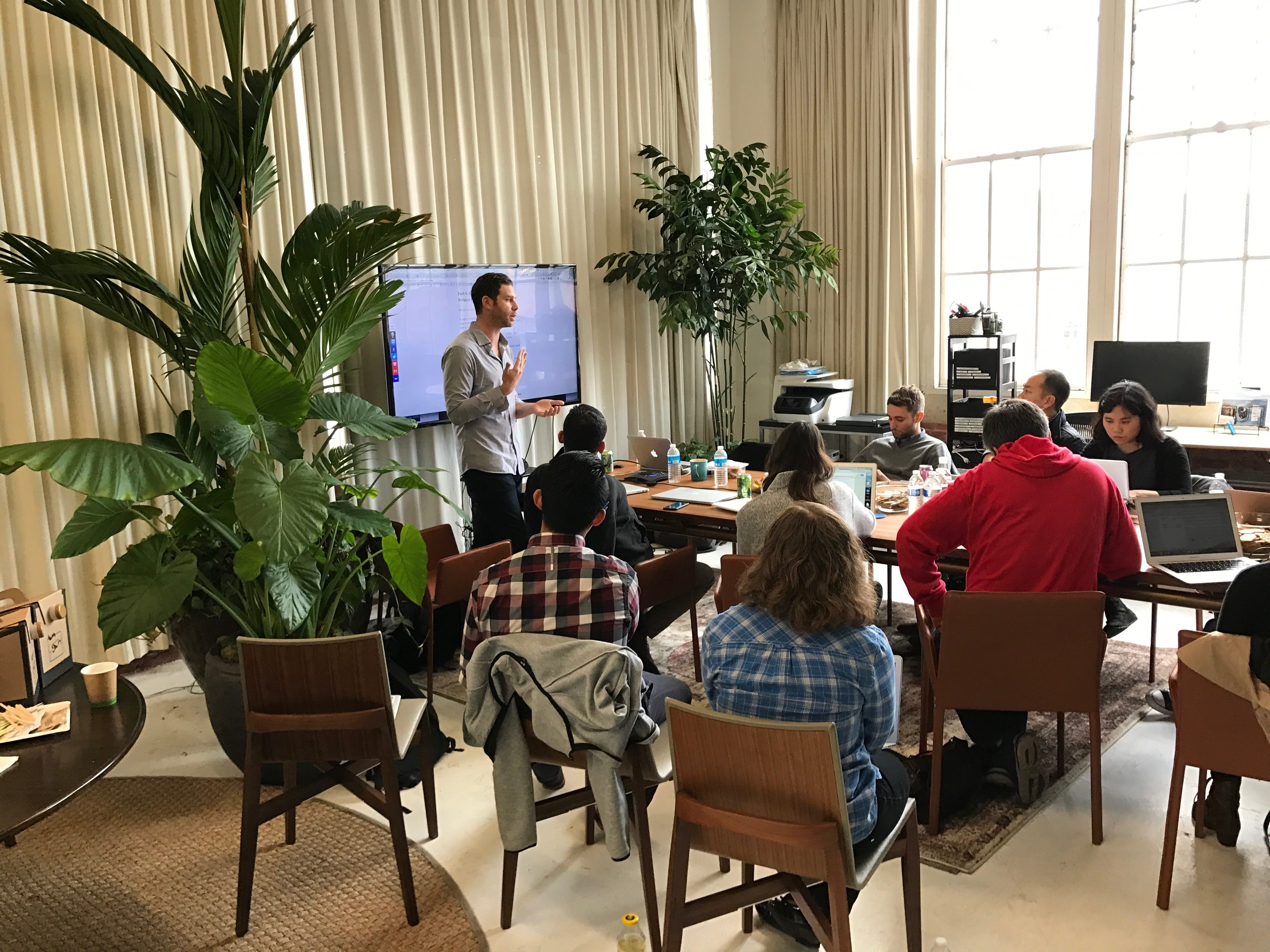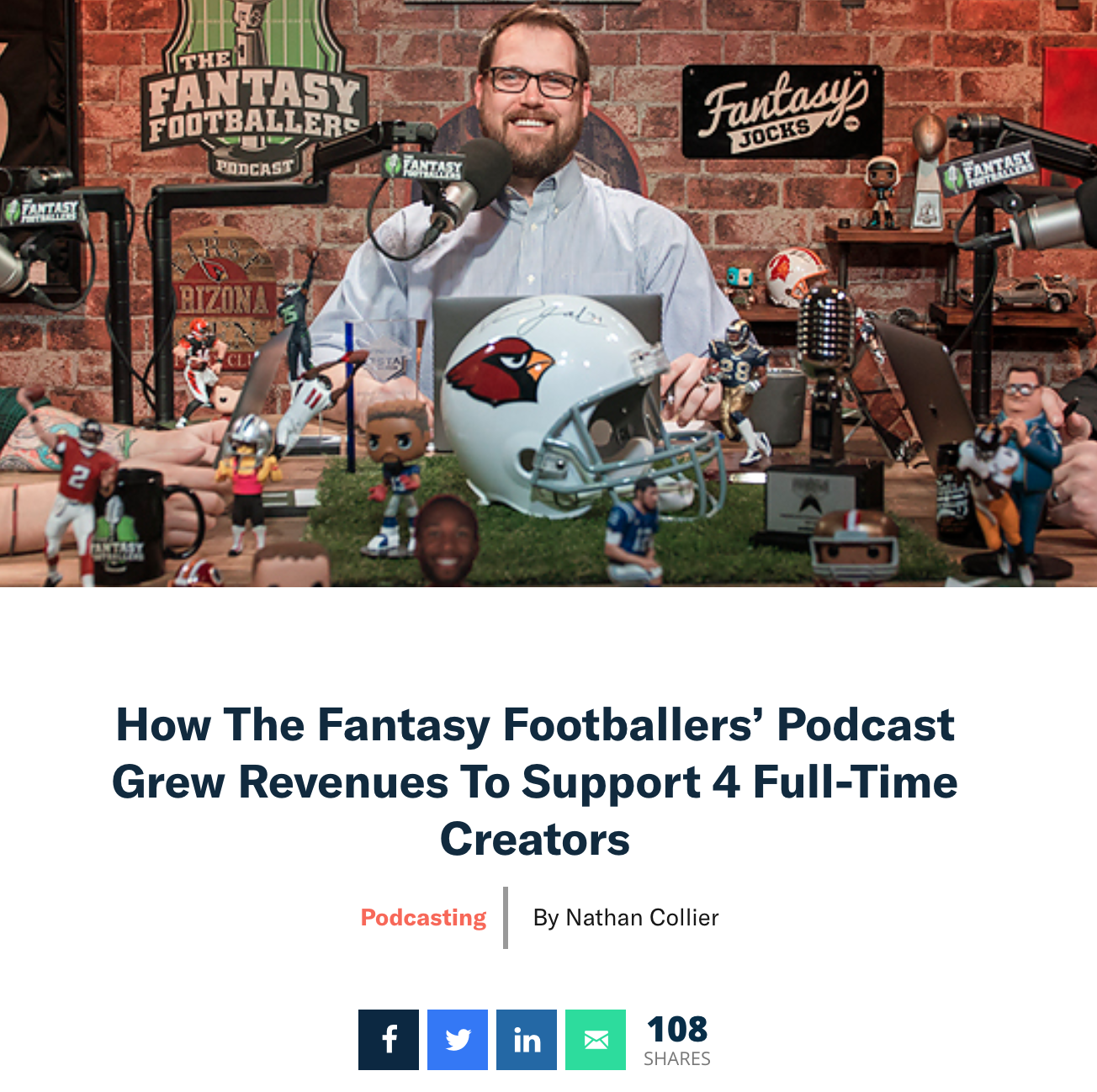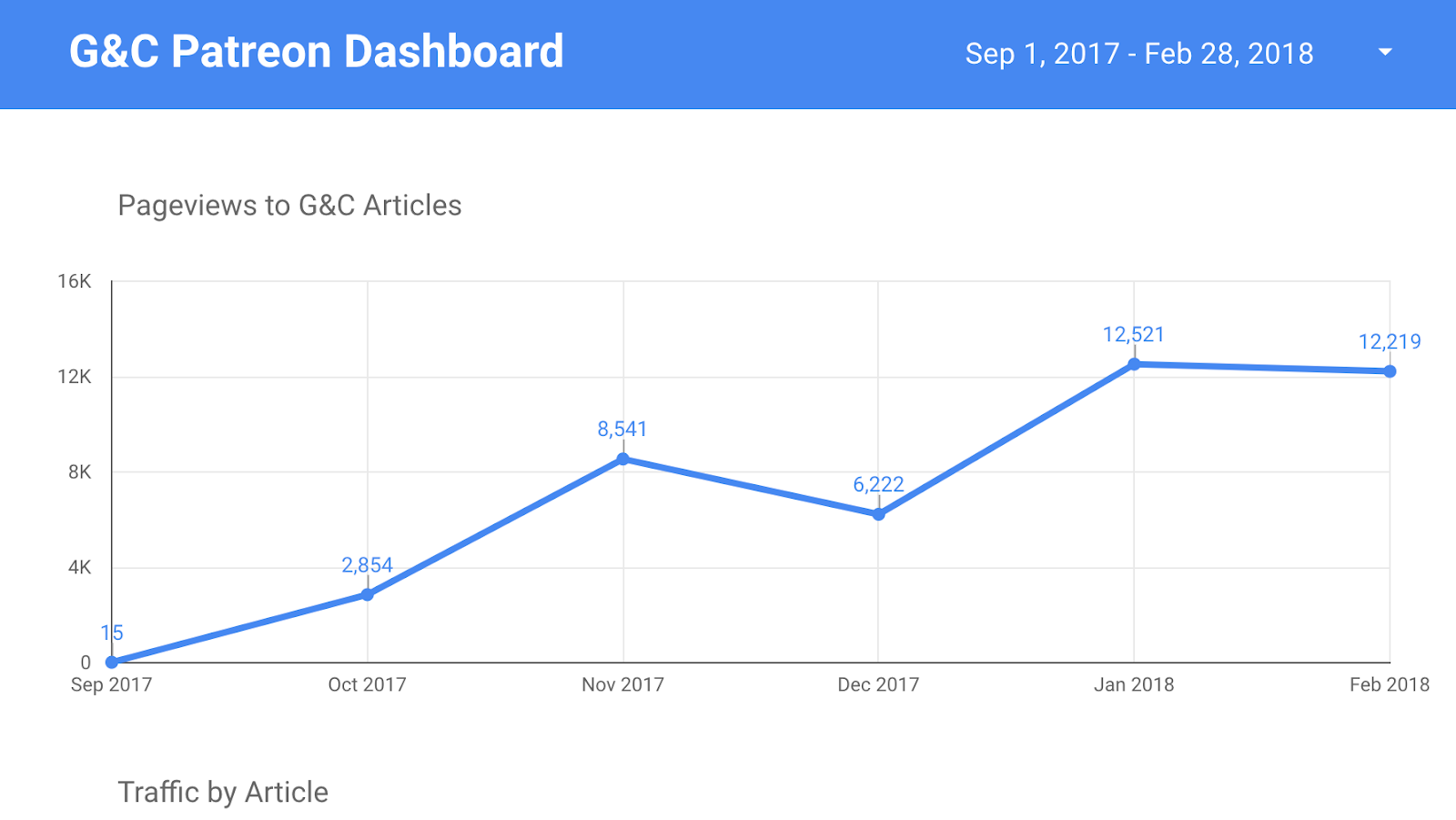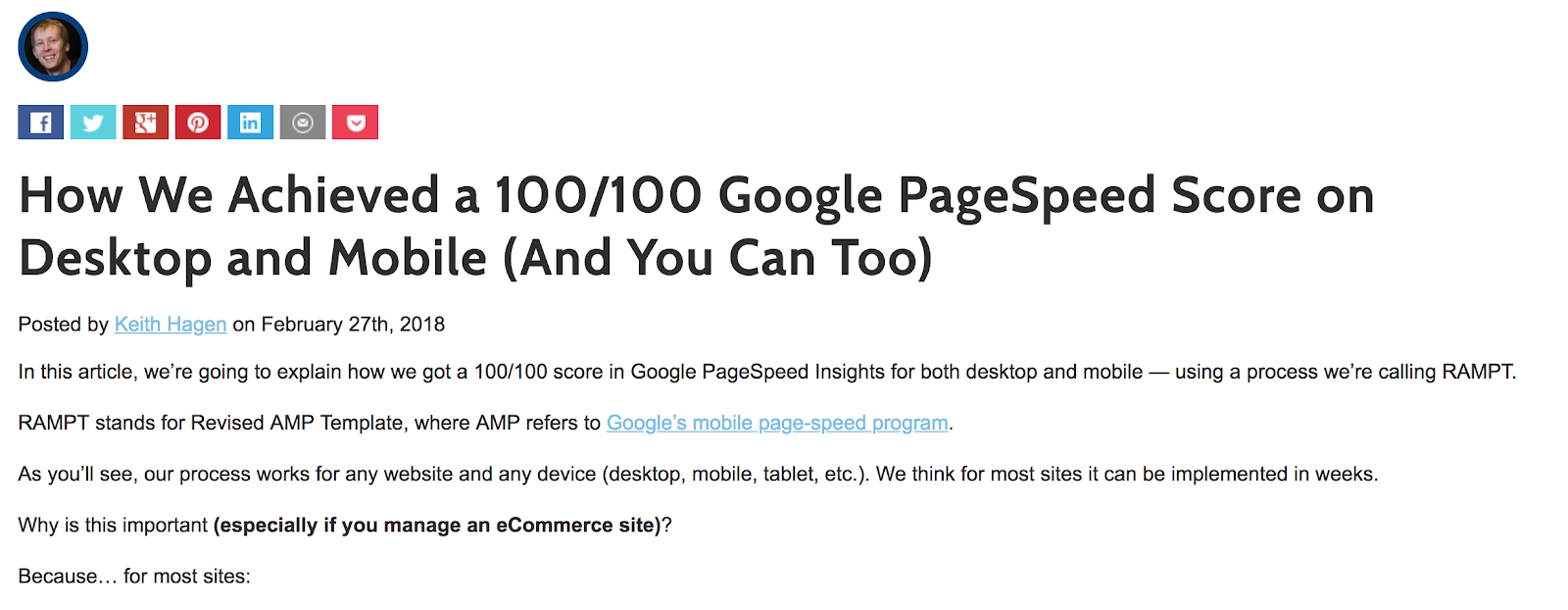When a company wants to work with us, we have them fill out a form on our work with us page asking a few questions about their content strategy, traffic, and more.
The most important question, bar none, is this one:
“What are your 6 month content marketing goals?”
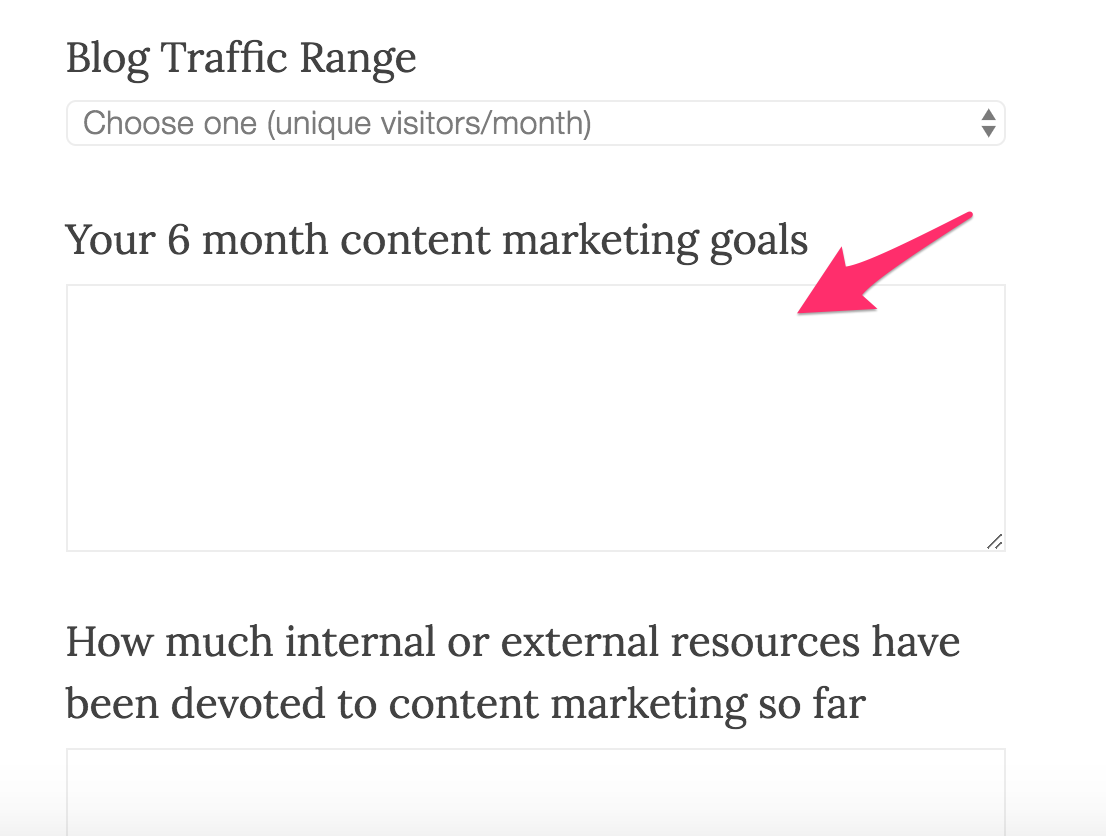
Here’s why this question is the most important: Your goals determine your content strategy.
And, we’ve learned over the years that all content marketing goals more or less can be boiled down to variations of the same two things:
- Goal 1: More traffic (i.e. traffic volume)
- Goal 2: More conversions (i.e. traffic quality)
That’s it.
Yes people articulate their goals in different ways, but what they mean is really just Goal 1 or Goal 2. For example:
- “We want to build more links/DA/[insert SEO thing]” = Goal 1, Volume
- “We want to produce more content, we’re not publishing enough = Goal 1, Volume
- “We get a lot of traffic, but it’s not driving leads/signups/sales” = Goal 2, Quality
- “We just released this new product/service, so we need to pivot our content” = Goal 2, Quality (It just means the current traffic isn’t the right kind)
So, your content goals are either a (1) volume issue or (2) quality issue, or most likely some mix of the two.
Now, based on this, you can outline your content strategy.
That’s because the types of content you should publish are a function of whether you’re focused on more volume, or more conversions.
The rest of this article will serve to:
- Back up this claim with 4 examples from 4 clients
- Present a framework for content types that help with these goals
This is one of our long, foundational pieces on content marketing, so if you want to skip ahead (e.g. to our 4 client examples), here’s a full table of contents:
2. Content Strategy for a Pre-Launch Startup
3. Content Strategy for a B2B SaaS Company
4. Content Strategy for a Venture-Backed Platform
5. Content Strategy for an eCommerce Marketing Agency
6. How to Incorporate Funnel Thinking Into Your Own Strategy
The Funnel Framework: How to Determine Your Content Strategy
We can only go into this in so much detail in a blog post. We go into frameworks in much more depth in our content marketing course and community, but here’s the simple marketing framework we use for ourselves and our clients in relation to content:
Top of the Funnel
This is content that generally appeals to your target audience, but is not directly related to your product or service. This type of content usually helps drive the most traffic because it appeals to a wider audience of people (Goal 1), but doesn’t usually drive the most leads (Goal 2).
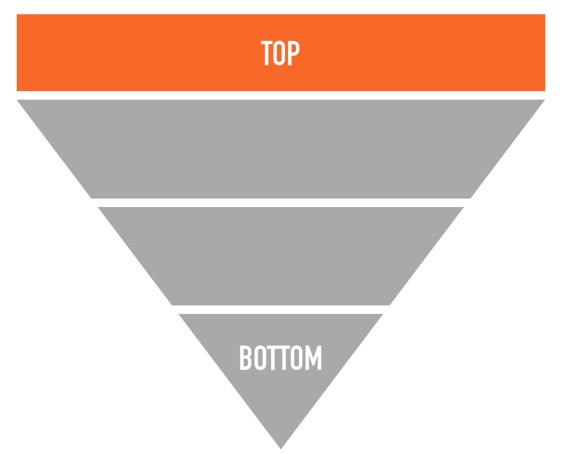
Many people like to say top of funnel content doesn’t drive conversions. This isn’t true. We’ve created many pieces that would be considered “top of funnel” that have driven leads for our clients.
Here’s our agency’s editor, Nathan Collier, on what makes a top of the funnel piece and why they are useful:
“The mistake many marketers make is making their product or service the hero of everything.
Stories that get shared are stories about someone who has done something that the reader aspires to achieve himself or herself.
You’re appealing to people’s dreams and aspirations.
If you were a startup founder working 80-hour weeks trying to grow your business, would you read about story about features in a new software product? What about a listicle promising 5 ways to be more productive?
Maybe, but probably not.
What about a story that described how another startup founder found a way to grow his business without working 80-hour weeks or sacrificing his health or his family?
There’s a much better chance you will.
Top of the Funnel stories get shared because they’re about people, not about products. And they should be written as such – making a person or company the hero of the story.”
For example, for our agency, the stories we did about How Examine.com Founder Sol Orwell Built A 7-Figure Business Off Of Reddit or Growing a Digital Agency: How KlientBoost scaled from $0 to $1M in 12 months would be considered top of the funnel. The reason being: they’re not directly about content marketing or something we’ve done, but are still interesting stories that marketers and founders, our target audience, would read.
Middle of the Funnel
This is content that is somehow related to your product or service.
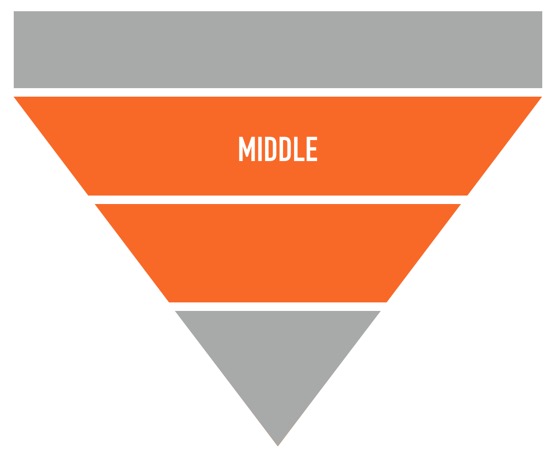
This type of content helps you build trust with your audience by showing thought leadership, results and expertise. It can help qualify, sell, or attract customers to your product or service but isn’t directly related to or aimed at customers who are actively making a buying decision right now.
For G&C, this is the majority of articles on our blog.
We produce so many of these articles for ourselves, and for our clients, because these articles do well at generating both traffic (Goal 1) and conversions (Goal 2). They’re broad enough to appeal to a majority of your target market but specific enough to attract the right buyers.
Unlike the top of the funnel story examples, our middle-funnel articles are about the core service we offer: content marketing. The type of people reading them are obviously thinking about, and have pain points around content marketing and are interested in advanced strategies. Thus a larger fraction of these articles’ readers are likely good customers.
For example, for our agency, we’d consider these ones middle of the funnel:
- Content Promotion: How We Grew from 0 to 32,977 Users in 5 Months With Zero Paid Traffic
- The Specificity Strategy: How to Turn Generic Posts Into Stand Out Content.
Reason being: these articles show that we know what we’re doing when it comes to content marketing and it helps us build trust with our readers.
Where do case studies fit in?
Case studies, articles that share detail or stories around what your product or service has done for customers (which you could argue includes this article), are somewhere in the middle/bottom category.
We thought about where case studies should fit in when writing this article and decided it doesn’t really matter whether you label them as middle or bottom. The point is, they serve to attract the right types of customers (if done properly), so they serve Goal 2 above more than Goal 1. So even though we’re arguing that this article is middle of the funnel, if you think it’s bottom, that’s fine.
Bottom of the Funnel
This is content that’s aimed directly at prospects that are about to buy.
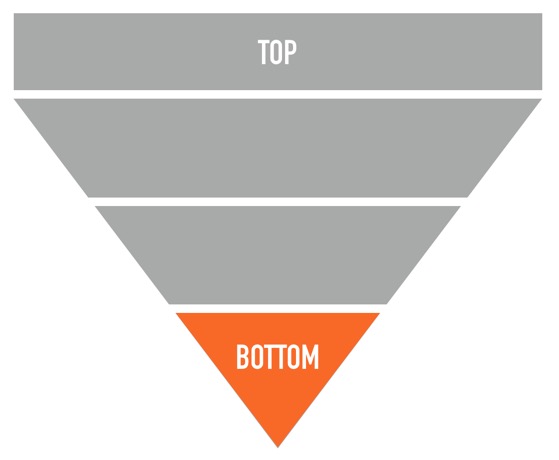
We don’t have many articles on our site that we’d really qualify as bottom of the funnel, but if we produced them for ourselves, they’d be topics like “Grow and Convert vs. another agency” “How much does Grow and Convert charge?,” etc.
The closest we could find is this piece on whether to hire an in-house content marketer or an agency. Even then it’s not really aimed at selling our agency (and in fact it was produced months before we even had one), so even this may not qualify.
Good bottom of funnel examples from our clients are these comparison pieces that are meant to rank for search terms when prospects are comparing our options for products in our clients spaces:


The type of people comparing options and making the searches above are literally at the bottom of the purchase funnel, they are about to choose an option.
How We Formed a Content Strategy for a Pre-Launch Startup
Content mix: Top and Middle of the Funnel
Fieldboom came to us a few months back with the challenge of helping them build their brand, get awareness to their product prior to launch, and helping them drive pre-launch signups and subscribers.
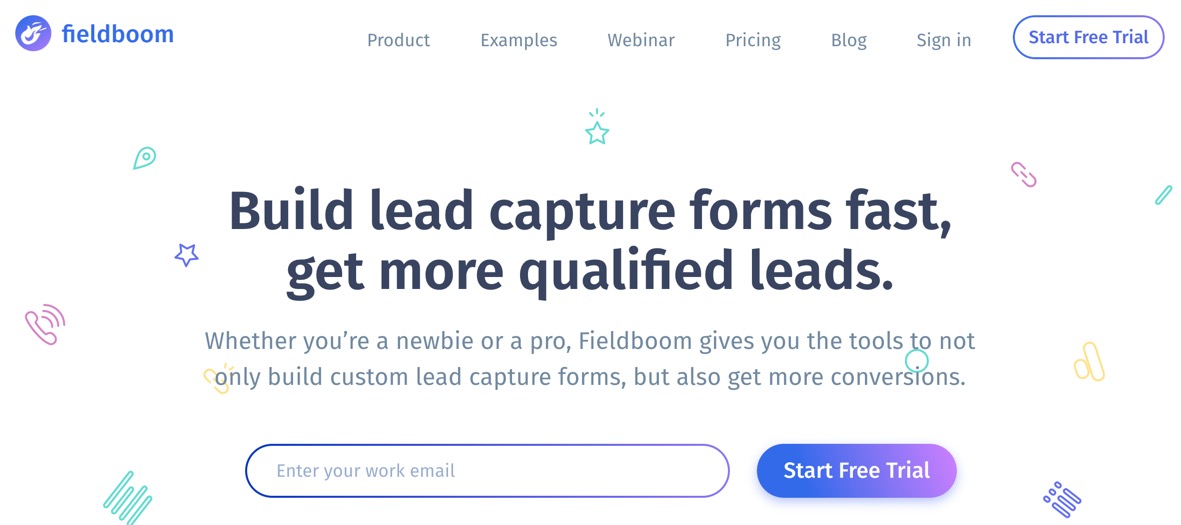
Because we started working with them at such an early stage, it would be unrealistic for us to be able to produce a bunch of revenue for them right from the onset of our engagement, because their product was pre-launch and they didn’t have a proven sales channel yet.
Their founder said their 6 month content marketing goal was to drive 100,000 of visitors to their site. Traffic for a company at this stage is a realistic goal and a challenge that we ended up taking on.
After our customer research session with them, we learned that Fieldboom is targeting marketers, founders of startups, and entrepreneurs. The first iteration of the product is a survey tool and the positioning is that it has a better UX (user experience design) and it’s simpler to use than the other ones on the market.
We ideated on what would be the best approach to help them hit their goals, and we decided that we were going to primarily focus on narratives (in depth stories with primary source interviews on topics and challenges that their target customers have) because it would serve as a good way to drive traffic and build authority.
Narratives are in large part top-of-the-funnel content and are more shareable than other types of content that we could produce.
Because our main focus was traffic, these articles serve as a great way to build that quickly.
Here are some examples of narratives we’ve produced:
This EXACT Keyword Research Process Grew Mindvalley’s Organic Traffic From 14k to 122k Per Month (In 11 Months)
(1,300 visitors to date)
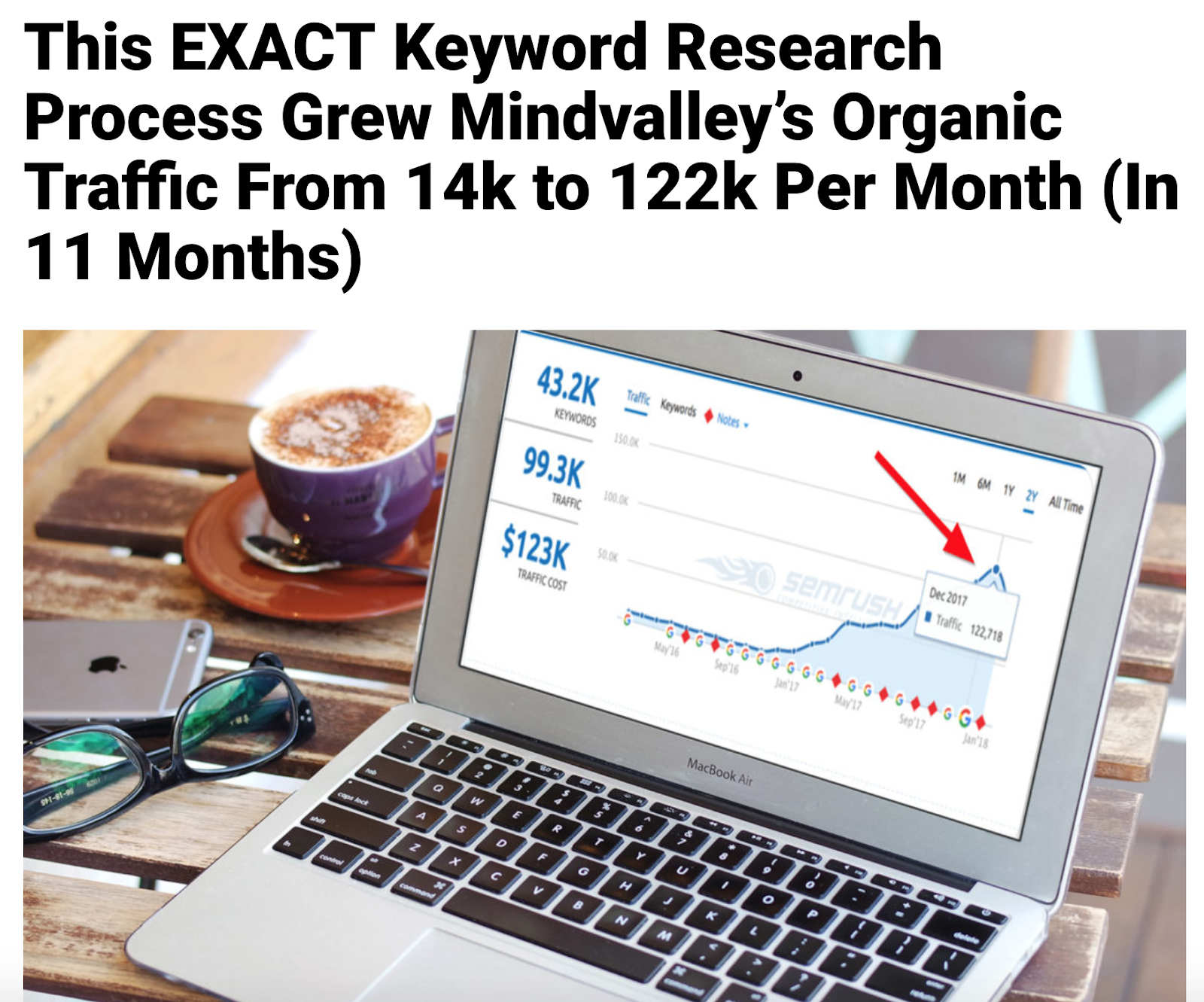
How Sarah Jones Grew SEO Traffic from 8k-30k in 4 Months by Binge Watching Rand Fishkin Videos
(3,700 visitors to date)
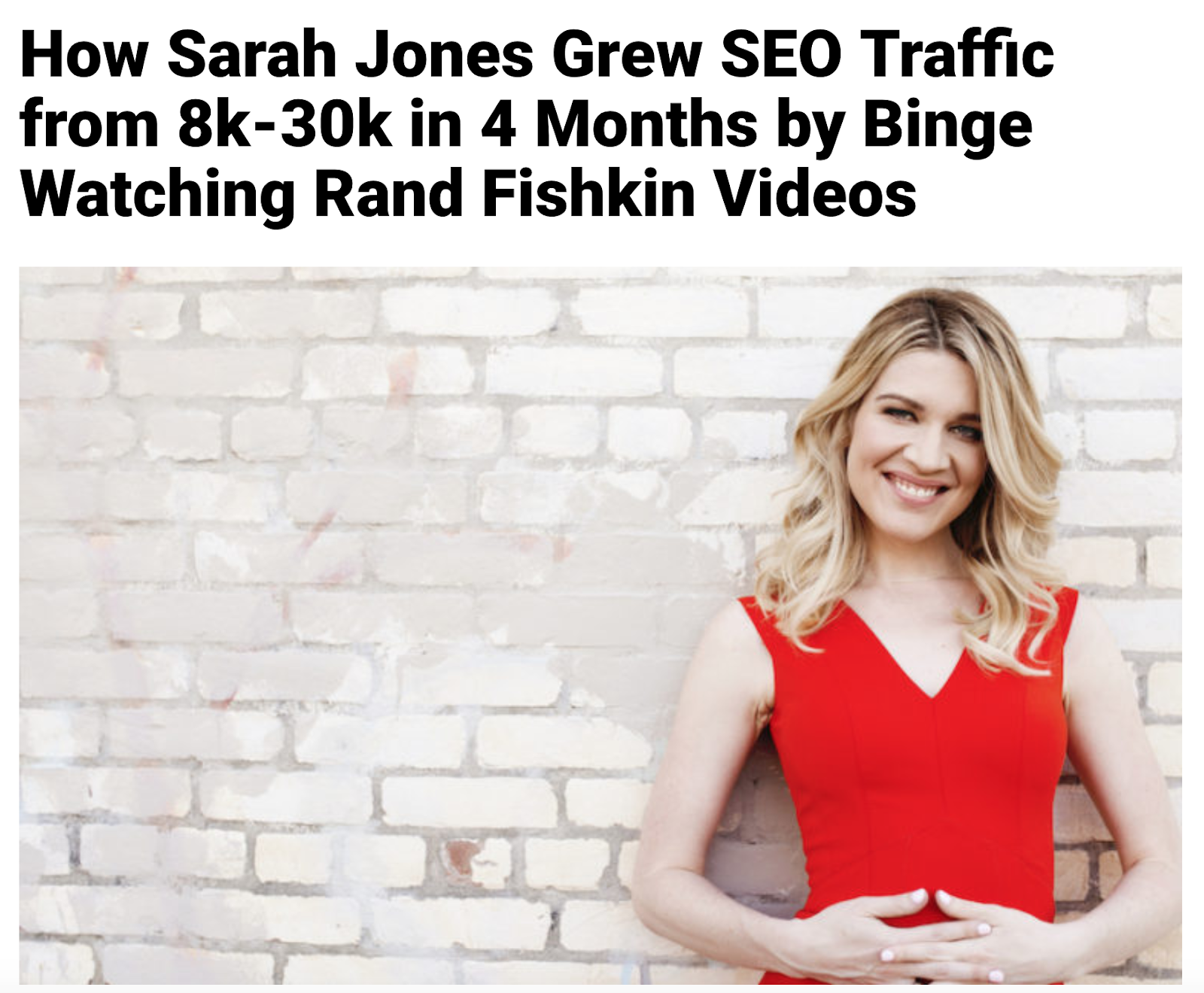
How PageCloud Did $1M in Sales Before Launching Their SaaS Product
(4,800 visitors to date)
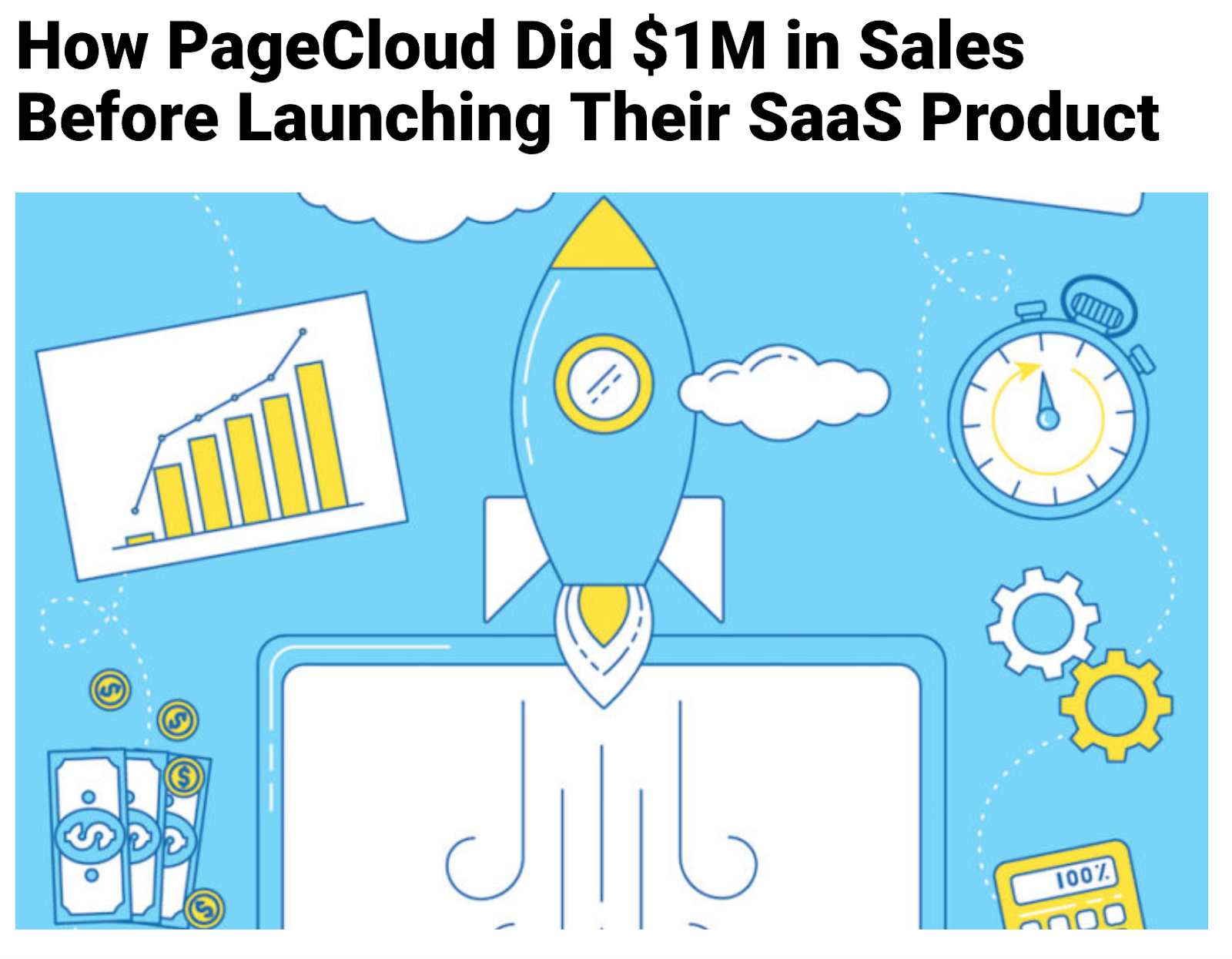
Note the quality and tone of these articles. Just because they are top of the funnel, it does not mean they are beginner level or Mirage Content.
Top of the funnel doesn’t just mean “SEO head terms”, which for Fieldboom could include things like “surveys” or “web forms”.
Yes they are top of the funnel, but they are also, to be blunt, kind of nonsensical. Their target audience isn’t likely looking for a general article on “surveys” (who is? 6th graders doing a research paper?).
The above articles are still appealing to their target audience, but they just aren’t focused on addressing product related pain points.
Mixing in Some Mid-Funnel into Their Content Strategy
Just because Fieldboom is pre-revenue, doesn’t mean that we can’t start planning for future conversions by producing content that doesn’t have as much traffic potential, but that will be a good piece for conversion down the road.
So we’ve also begun building more middle-of-the-funnel content for them too – this is content that might not get as much traffic, but content that proves that the company is an authority on their topic and proves the value of the product.
For example, we created this piece on survey questions that helps prove Fieldboom is an expert when it comes to survey creation.
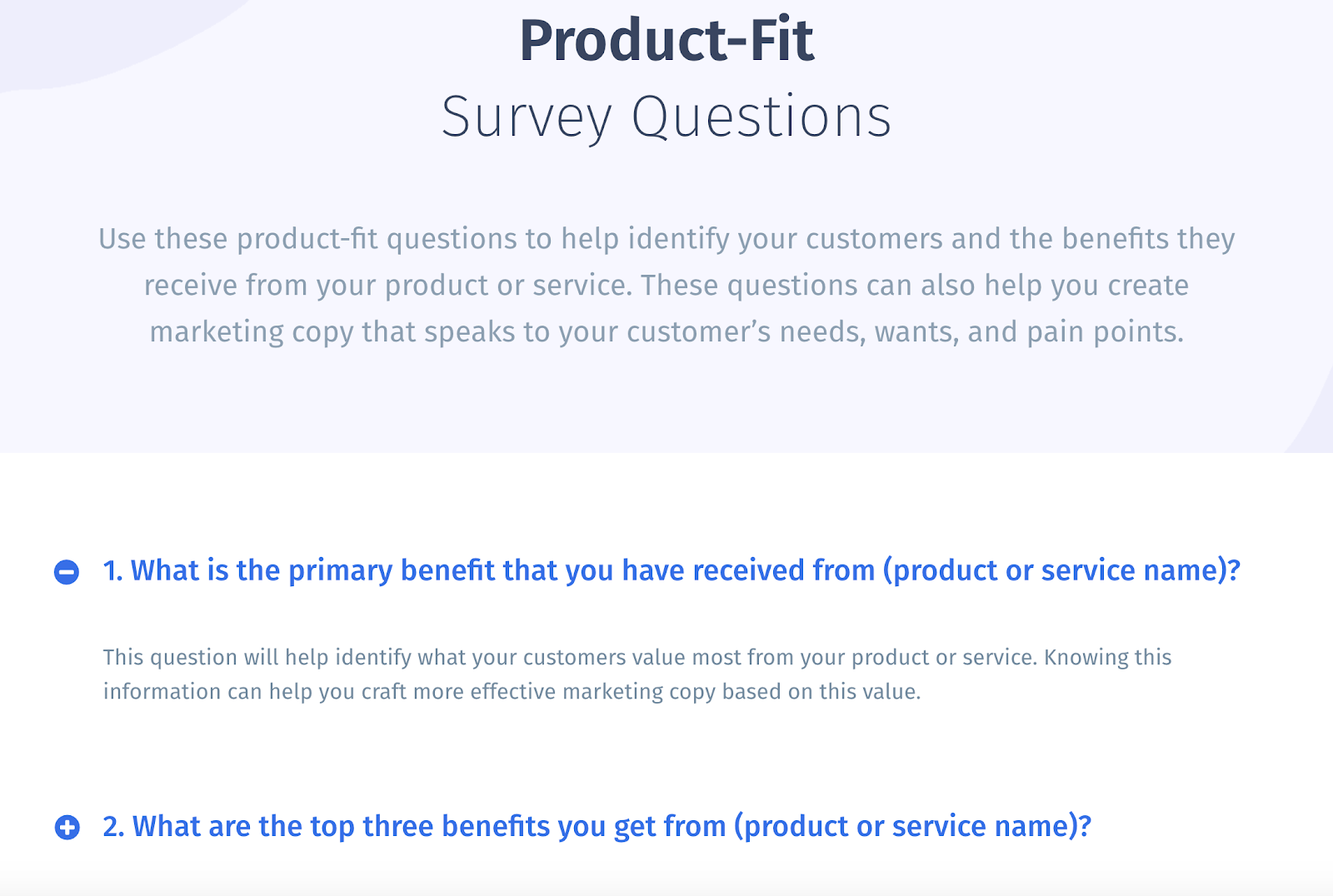
Think about the difference between someone searching for “survey questions” (which a marketer or founder that’s looking for ideas on surveying their customers could search for) and the example I tore down above on someone searching for “surveys” (which, who knows what that means).
In the last ~4 months working with them, we’ve largely hit on that goal of driving traffic for them:
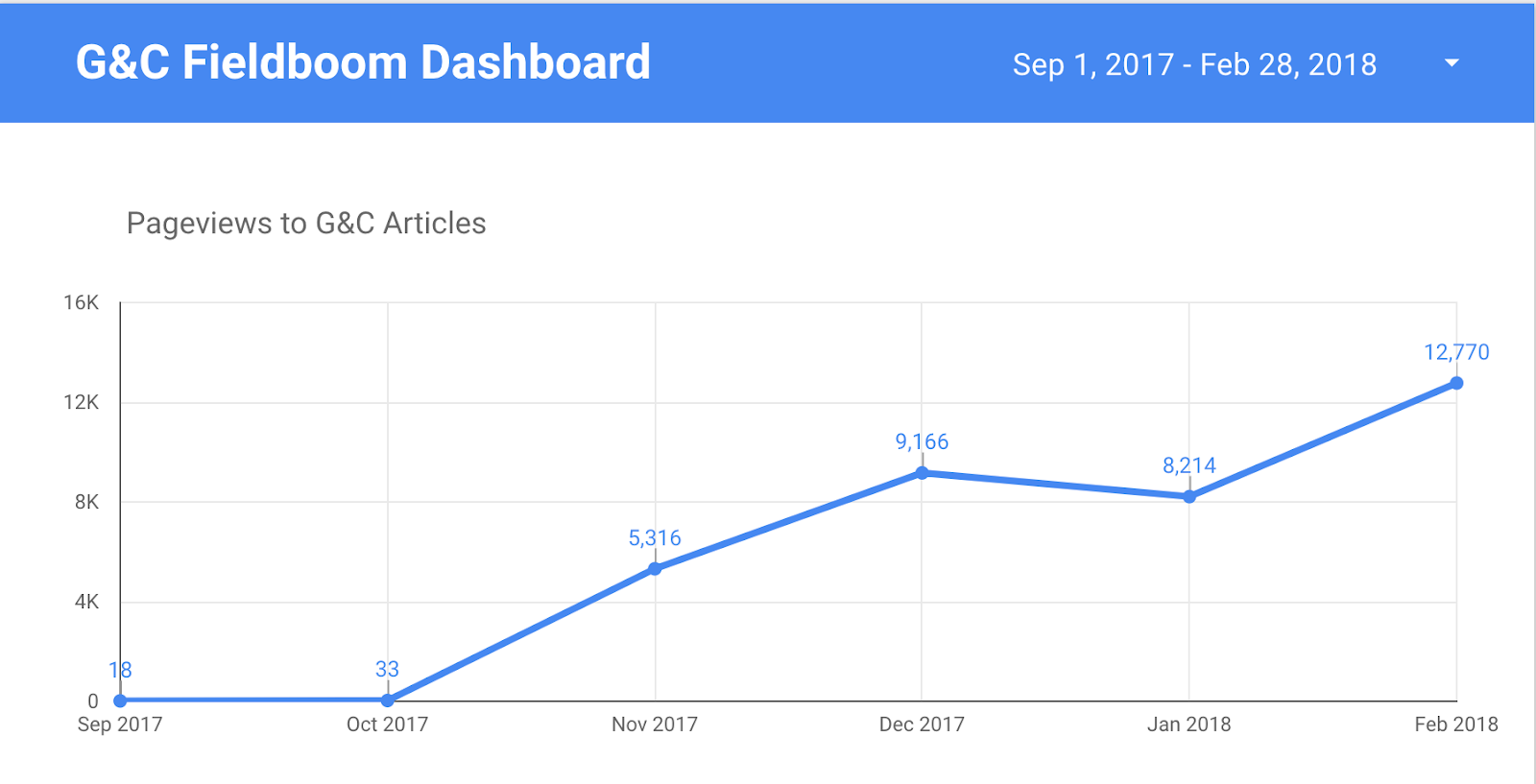
What you’re seeing above is pageviews to only the articles that we produced for them. In the first month (Nov) we immediately drove over 5,000 pageviews. Four months in (Feb) we got up to over 12,000 pageviews. Pretty nice, and that’s the power of community content promotion.
But as we’ll see in the following examples, you won’t always get that kind of traffic, and that’s okay.
How We Formed a Content Strategy for a B2B SaaS Company
Content Mix: Top, Mid, and Bottom
Yes, we do all three for Leadfeeder, let us explain.
When Leadfeeder came to us back in September, they told us that they had a blog that was driving traffic, and that they wanted to get more leads from content marketing, so Goal 2.
Leadfeeder has been around for a while, they have a proven marketing/sales channel, have clear positioning, and have proven numbers to show they knew how to convert free to paid signups.
![]()
Our approach for Leadfeeder was different than the approach we took for Fieldboom because of the stage they were at in their company. Leadfeeder was looking for an increase in traffic, but more importantly they were looking for content that would help them build their brand awareness amongst their target audience, and drive signups.
So in other words they wanted a somewhat equal mix of Goal 1 and Goal 2 (we’re not here to slice and dice whether it’s 50/50 or 60/40, the point is it’s largely both).
When we conducted our customer research session with them we learned that the buyer is predominately marketers however the user is predominately sales and marketers. So we formulated a strategy that would attack the top, middle and bottom of the funnel so that we could equally focus on traffic and conversions.
The first thing we did with Leadfeeder was create a comparison post (a really bottom of the funnel article) because one of our goals was around signups and we wanted to be able to have a pillar piece of content that could continue to drive signups long-term.
The strategy here was to take other companies that had large brand share in the space and target their names in search, and insert Leadfeeder into the conversation.
Leadforensics vs. Hubspot vs. Leadfeeder
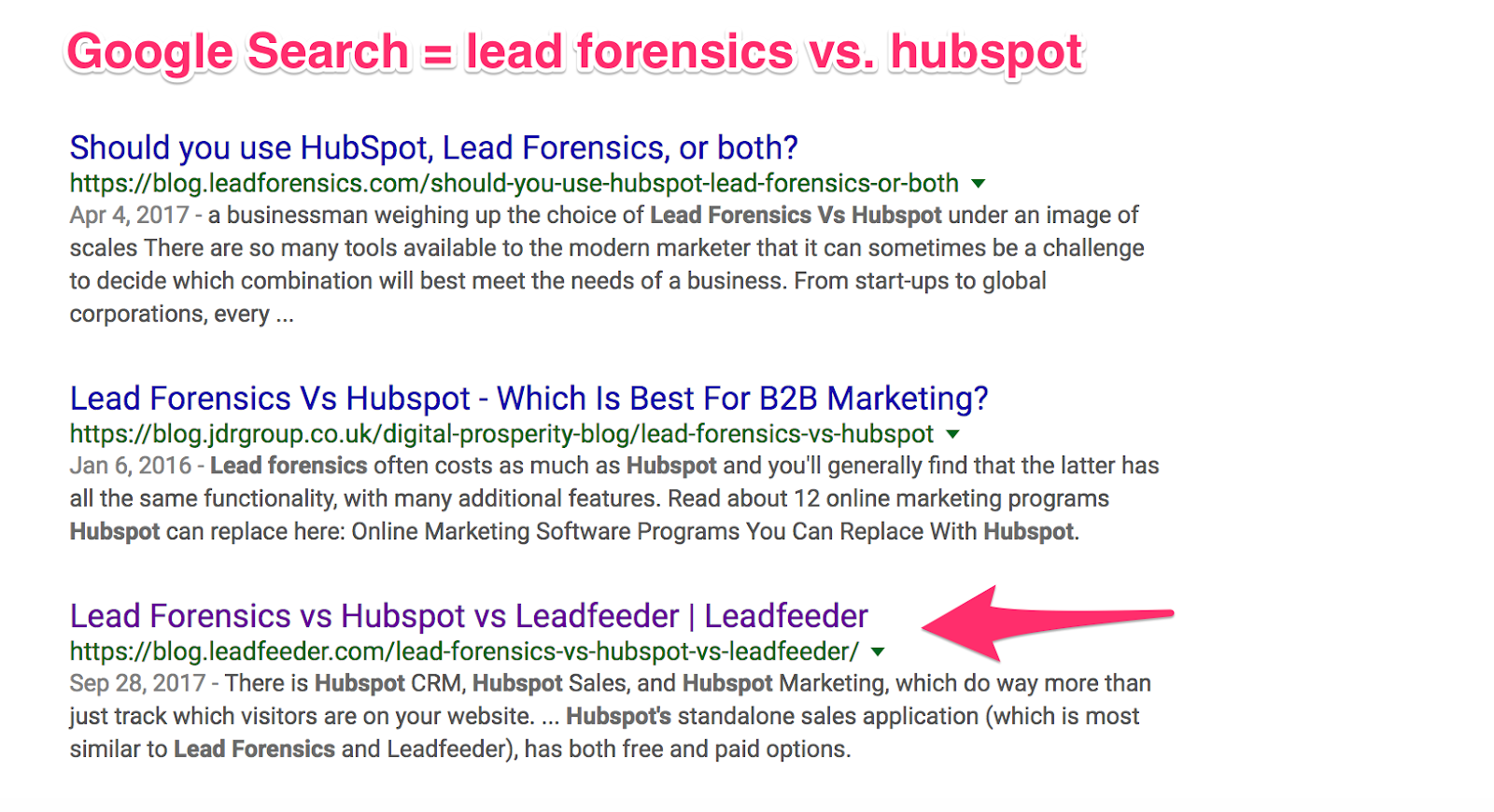
While it took longer to get traffic to this article, because we needed to wait for it to rank in search, it now appears in search ranking on the first page for various search terms, and the traffic that it attracts is highly qualified. Thus, it’s no surprise to us that this is one of the highest converting post for them.
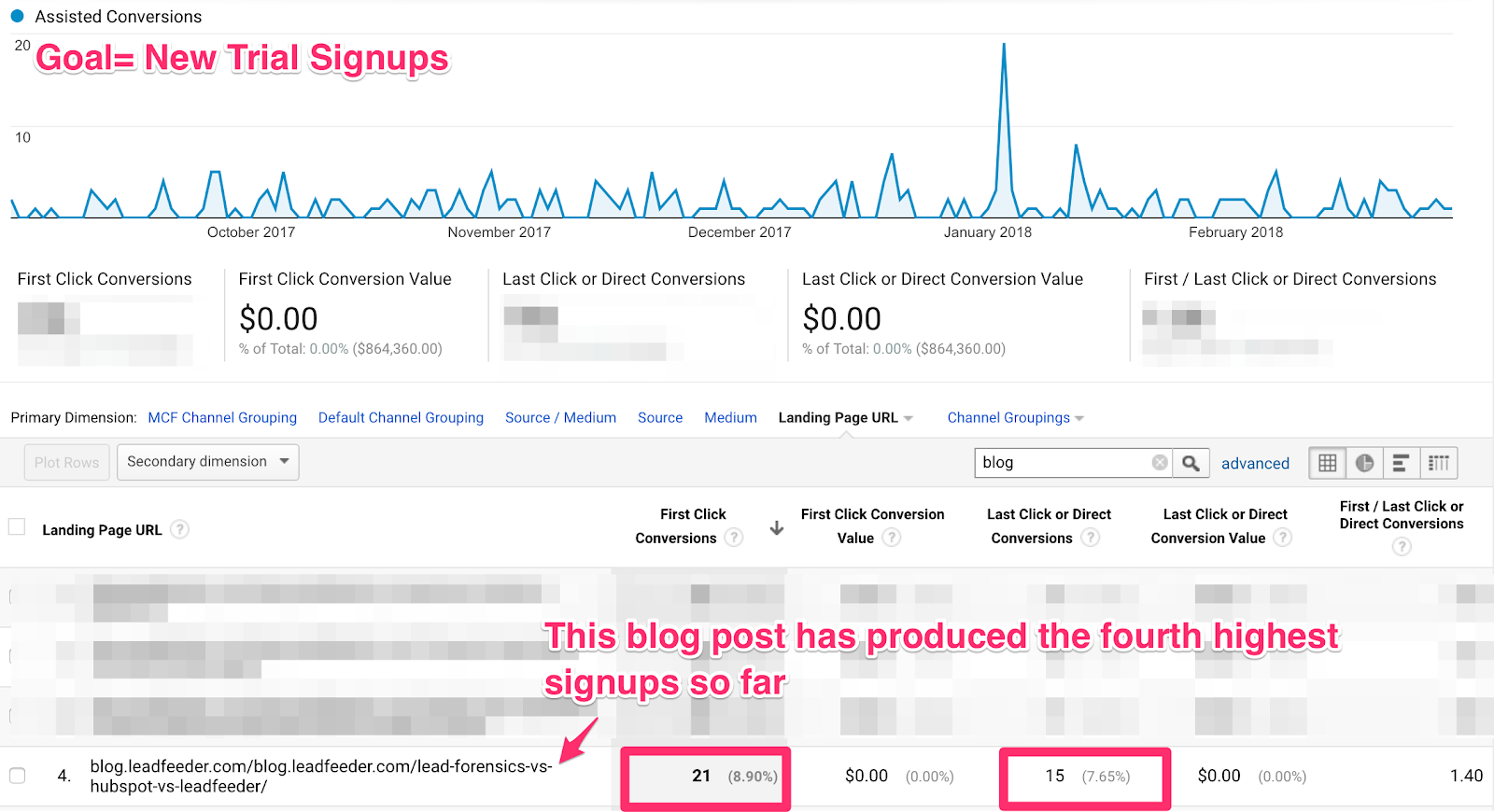
Free trial signups from Sep 1 – Feb 28
To supplement that lower traffic on a monthly basis from this post, we decided to start producing some top-of-the-funnel content to get the Leadfeeder name out there and start building more authority in the marketing world.
We produced this piece of content “After writing 10,000 cold emails for 550 companies, this CEO shares her strategy for getting higher response rates.”
Over the past 3 or 4 months since publishing it, this is the number one post in terms of traffic on their site, and it’s also one that has driven a lot of signups.
The learning = just because you produce a narrative that is shareable and meant to get traffic, doesn’t mean it still can’t get leads as well.
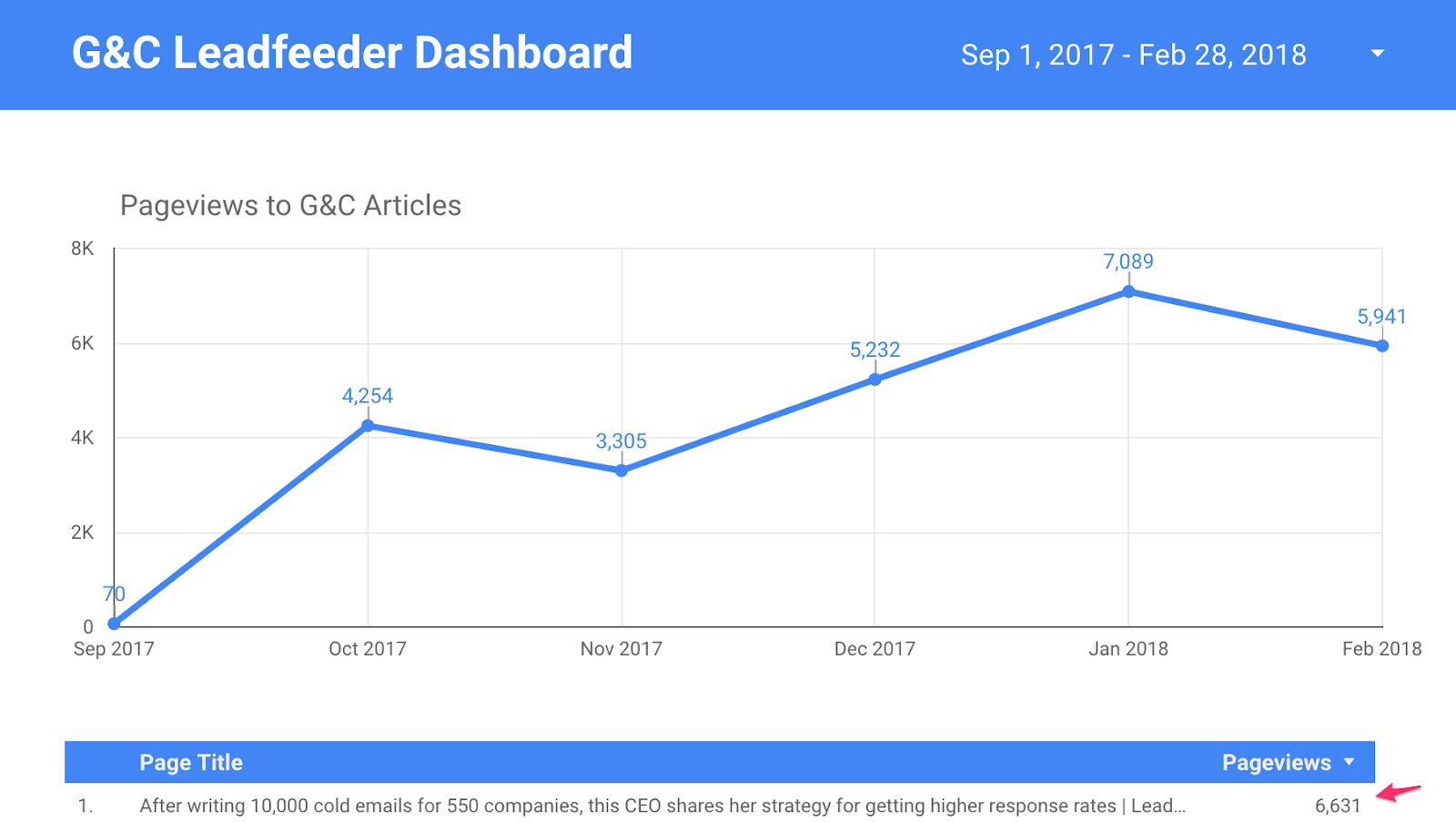
Again, the big difference in the way we approached content marketing for Leadfeeder is that we needed to balance traffic growth with content that we knew would drive signups for them.
The goal here is not to drive as much traffic as you can just for the sake of having high traffic numbers, we need to focus on balancing traffic growth with producing content that we know will drive signups and help with retention amongst their current users.
How We Developed a Content Strategy for a Venture-Backed Platform
Content Mix: Mid, Bottom
Patreon came to us with a few different challenges:
- They wanted to attract more creators with established audiences
- They wanted to start publishing content consistently (they had been relying on internal staff to produce content and they were only publishing new posts about once per quarter)
- They wanted to learn which kinds of content produces more signups and start measuring ROI (measured as signups)
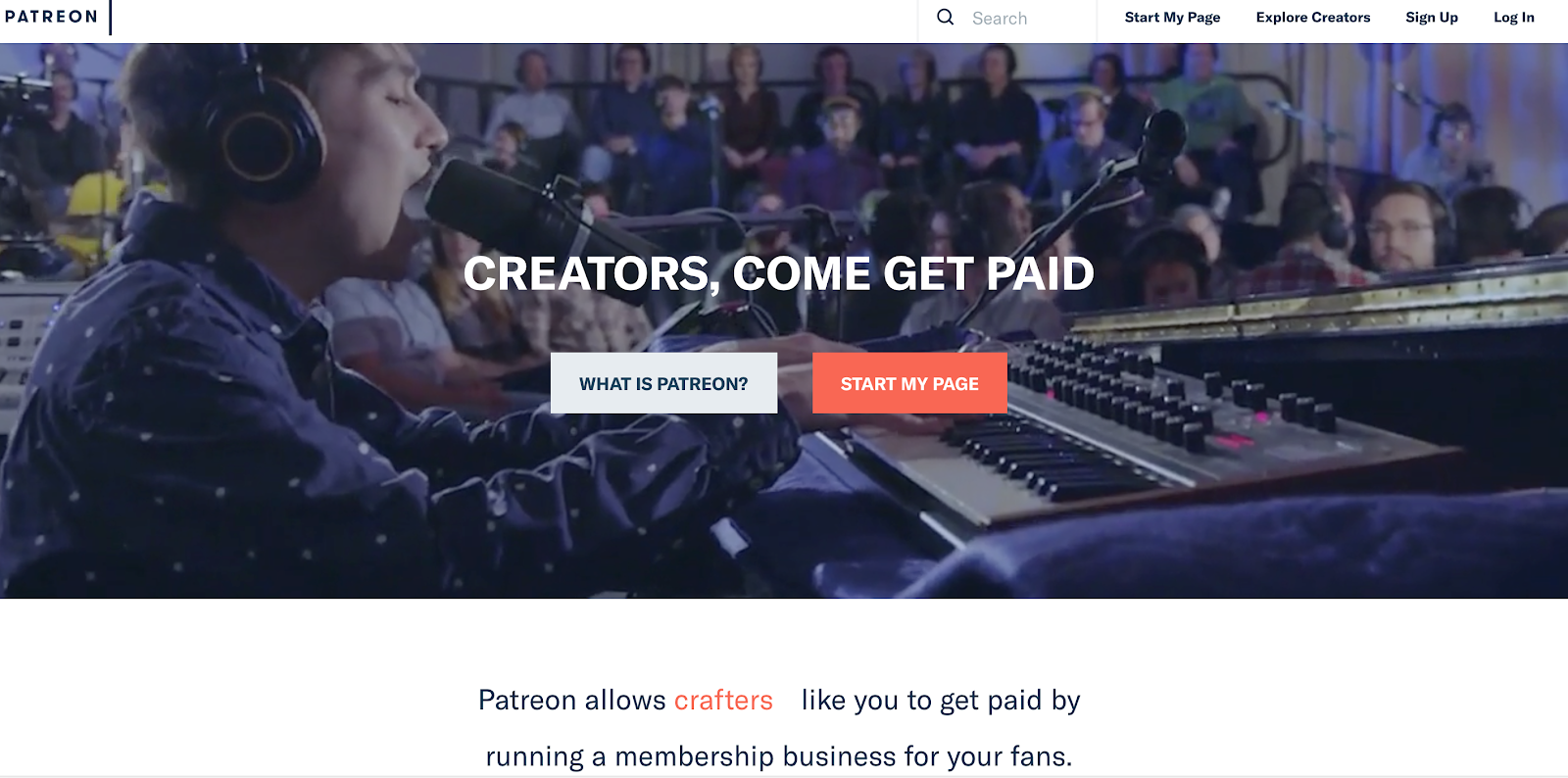
When we conducted user research with them, we learned that they already had really high brand awareness in their target market, most of the signups they were getting were coming from creator pages (people were finding out through Patreon through referrals from their existing users), and “creators” (the name for their customers) had 7 main pain points when it came to growing a business.
Since Patreon already had a large brand, a site that gets hundreds of thousands of visitors, thousands of customers, and large distribution channels, we decided that we’d take a unique approach for them.
We decided that the most impactful and low-hanging fruit way that we could achieve the goals they had set forth was to focus on producing mid-funnel and low-funnel content for them – since they didn’t need more brand awareness.
The mid-funnel content that we chose to produce were stories that helped potential Patreon users see the value that the Patreon platform had to offer. What we did for them is source stories from prominent creators in their community and share case studies about how they overcame common challenges that most creators faced.
For example, here are some of the stories that we produced for them:
From Financial Distress to Monthly Income: Jack Lowe’s Journey as an Independent Creator (this shares the story of a creator who recently overcame the $1k/month hurdle)
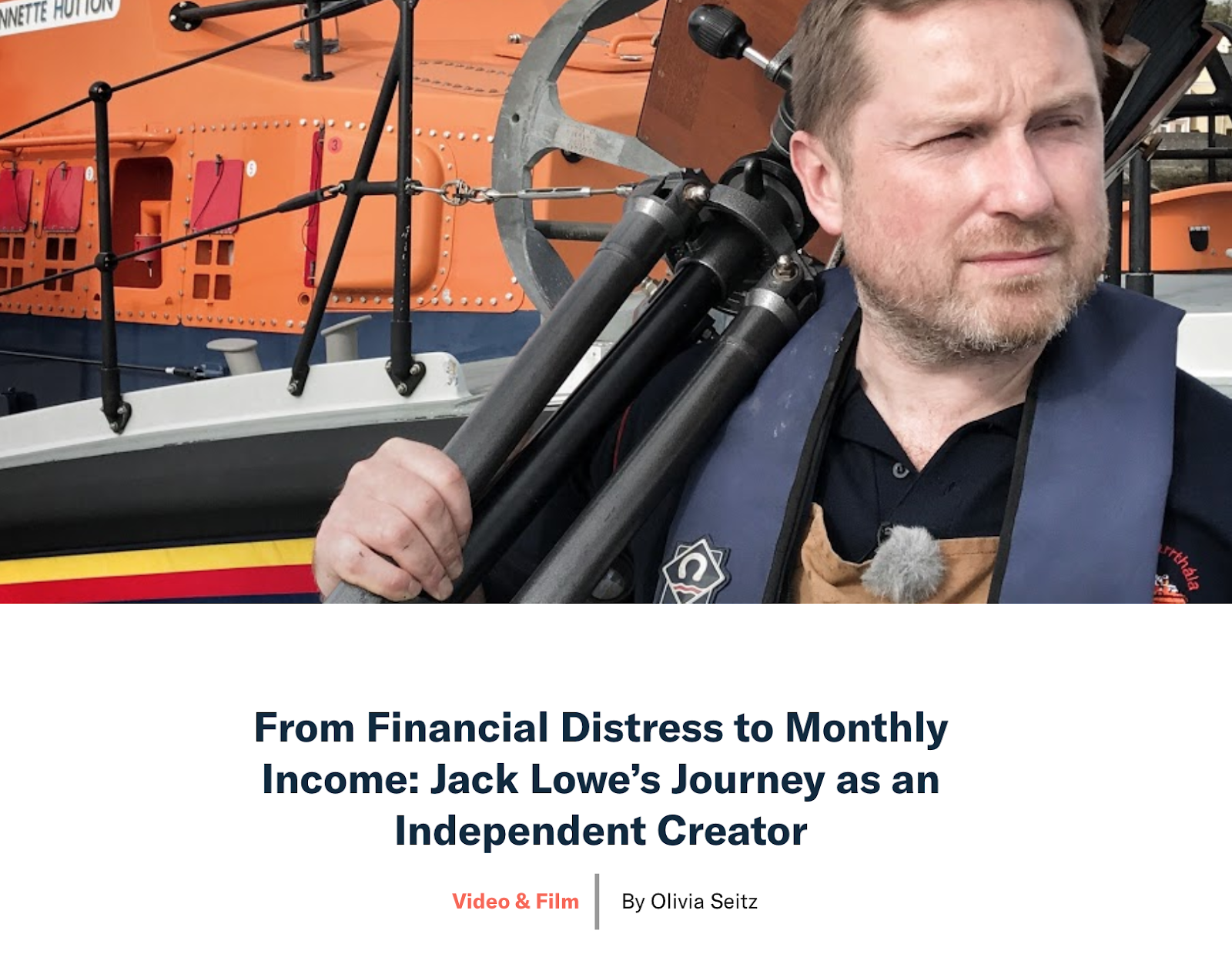
The Comic Artist Who Walked Away From DreamWorks
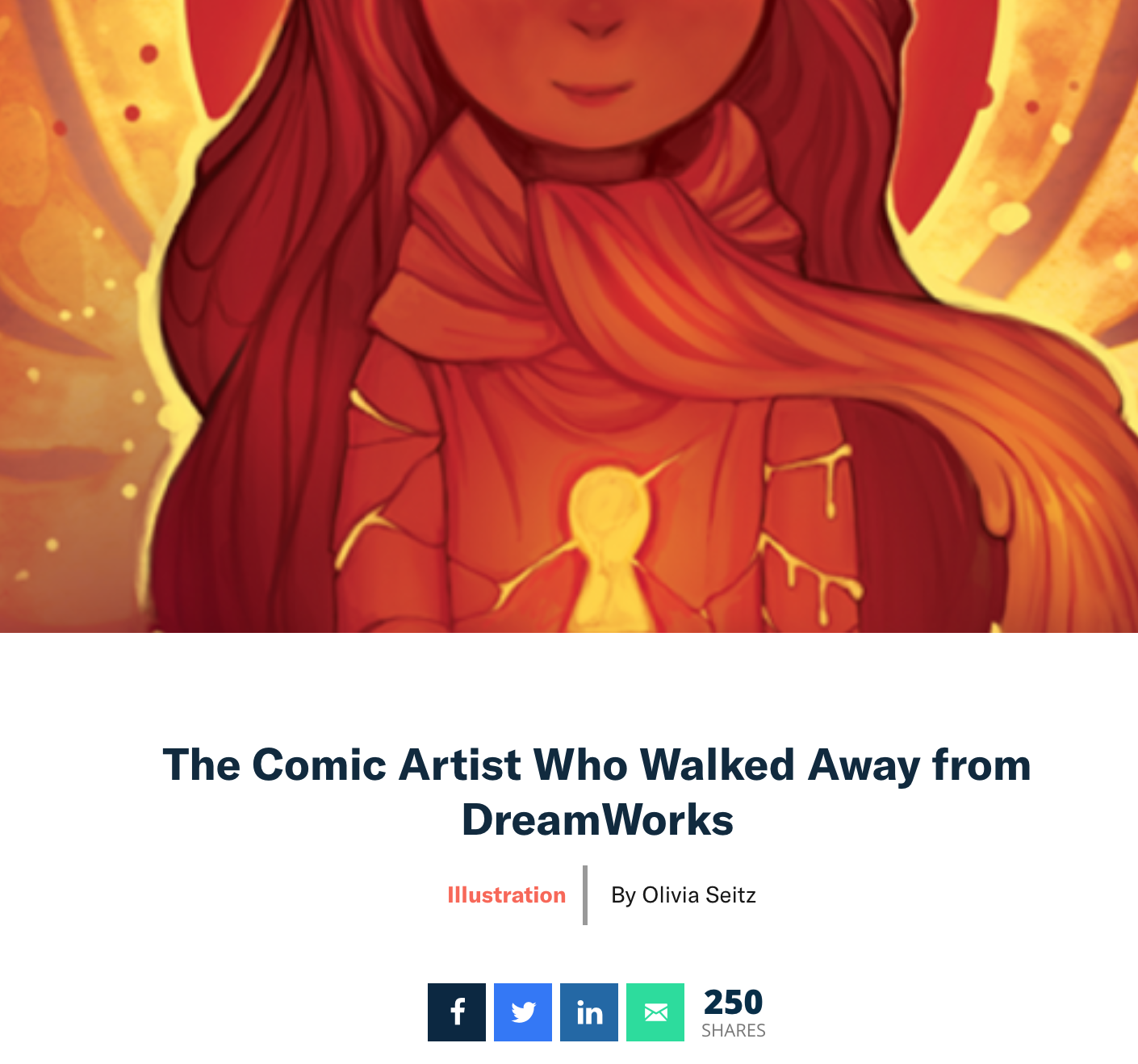
The thinking behind producing this kind of content was that if most signups right now on their platform come from creator pages, then by telling stories about successful creators, we’d be able to attract other creators who might be interested in signing up for Patreon, to this content.
Also, we’d weave in the value of Patreon into these stories so that we could show proof that Patreon was helping these creators achieve their value prop of “Patreon allows creators like you to get paid by running a membership business for your fans.”
We also helped produce some bottom-of-the-funnel content for Patreon and we have a lot more of it planned for the future.
Another challenge that Patreon faced is around onboarding new creators. We wanted to help create content that would make it easier for Patreon creators to signup for Patreon and get started on their platform.
So we created a few different style of pieces to hit on this.
The first piece we created was a piece about a feature that they had launched and we wove a story into it to make it interesting to all creators looking to make a membership site.
How The Fantasy Footballers’ Podcast Grew Revenues To Support 4 Full-Time Creators
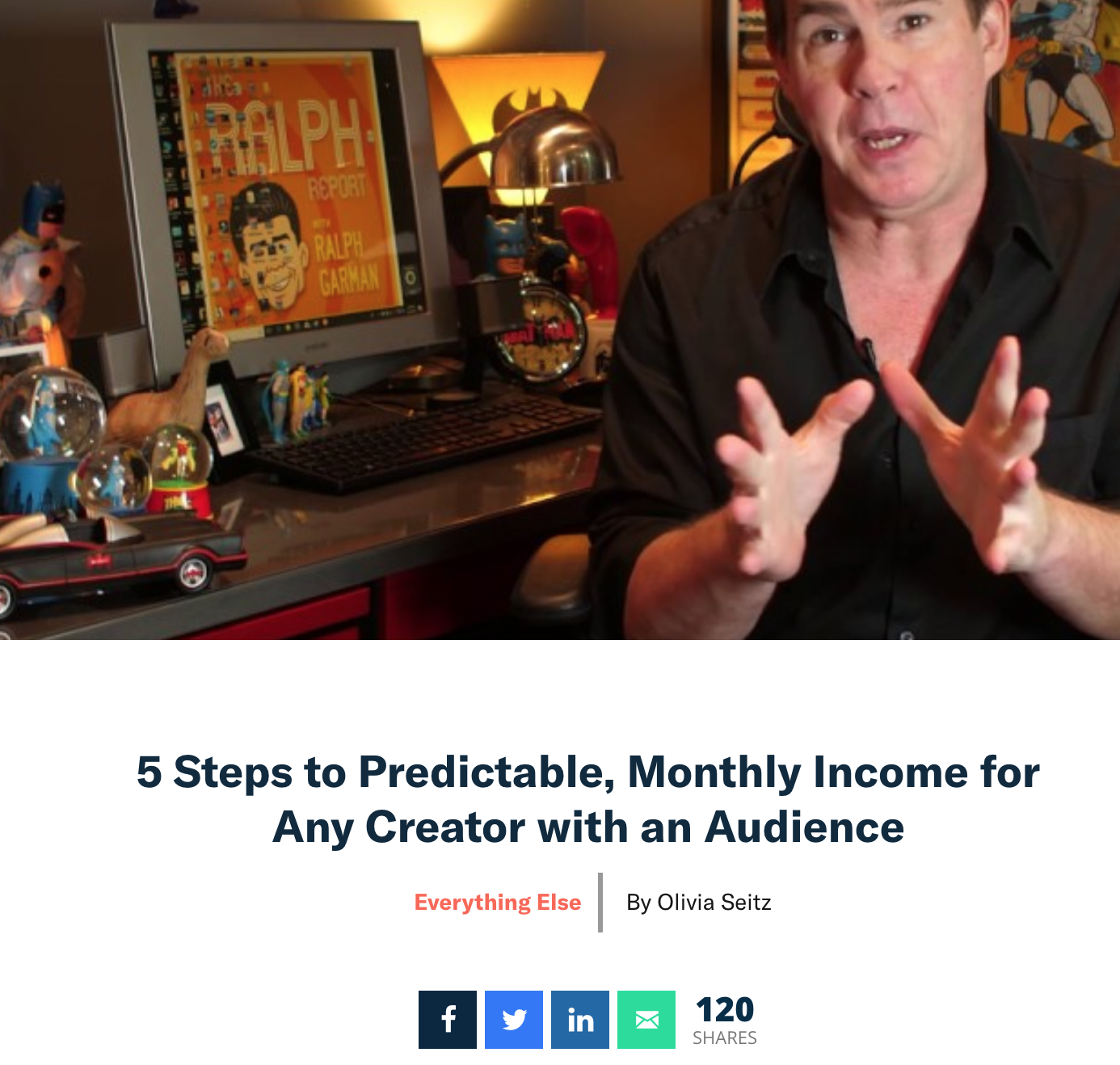
And we recently just created a piece about how creators are using a new feature in the Patreon app to create deeper connections with their fans.
Patreon Lens: How 5 Creators Are Giving Patrons Behind the Scenes Access to Their Work and Life
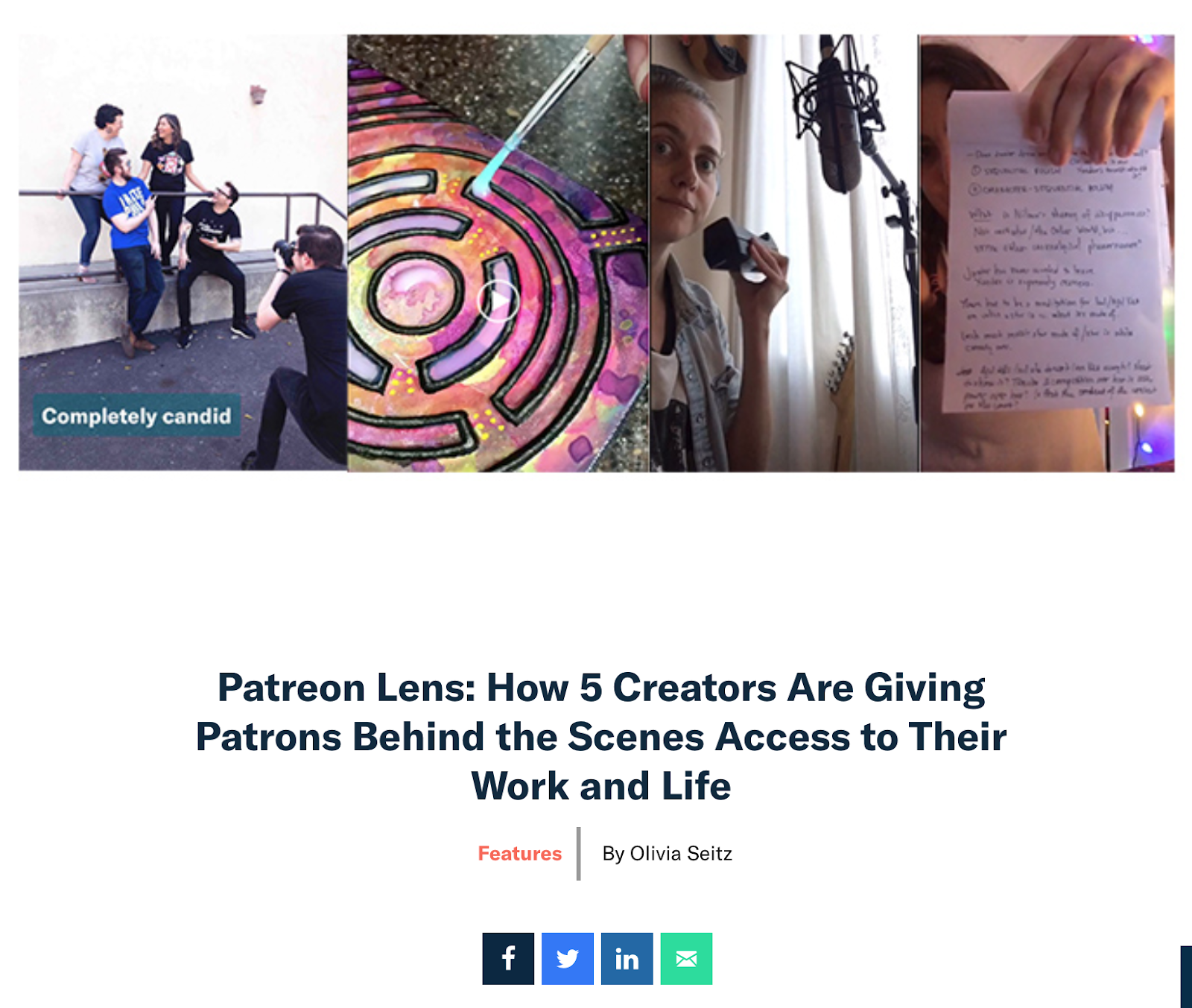
While the bottom-of-the-funnel pieces don’t drive nearly as much traffic as the mid-funnel pieces do, they’re essential to help the creators to their end goal of being successful on the Patreon platform.
The mid-funnel pieces do two things – they prove the value of the Patreon platform to the creators and they serve as interesting stories to attract new creators.
Since working with them, we’ve been able to drive a steady stream of traffic to their site from the stories we’ve created.
How We Developed a Content Strategy for a Well-Known eCommerce Agency
Content Mix: All Middle
Inflow came to us back in November after an employee moved on from their role and they needed someone to come in and produce content that did two things for them: helped increase the traffic to their blog and converted that traffic to paying customers.
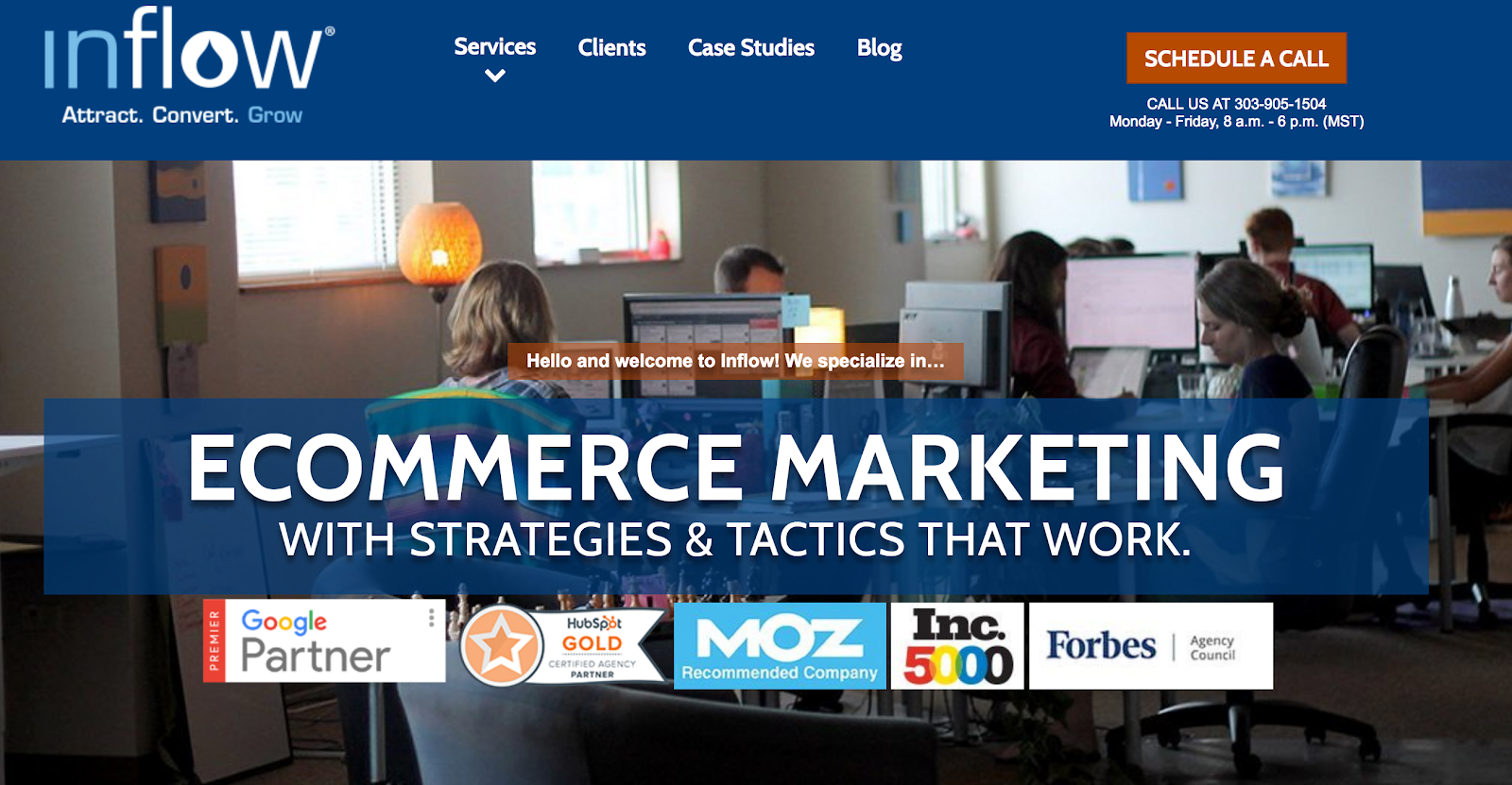
After doing their customer research, we realized they were sitting on a ton of case studies and had a really smart team. We decided that we’d produce case studies for them and opinion pieces around trending industry topics. As we explained above for our own agency, these are golden for getting “the right traffic” because they show your future customers the results you’re currently getting for your current customers. Case studies in a way “auto qualify” your readers.
The approach we took for them was to ghostwrite stories on behalf of their team that outlined achievements and learnings they had around different service areas – CRO, SEO and paid search.
We decided to exclusively produce mid-funnel case studies for them being that it would do two things – the stories would be interesting and attract their target client, and they’d also serve to prove that Inflow know what they were doing when it came to client services.
Here are some examples of the case studies we produced for them:
How We Helped Skreened Achieve a 360% ROAS in One Month on Their Google Shopping Campaign
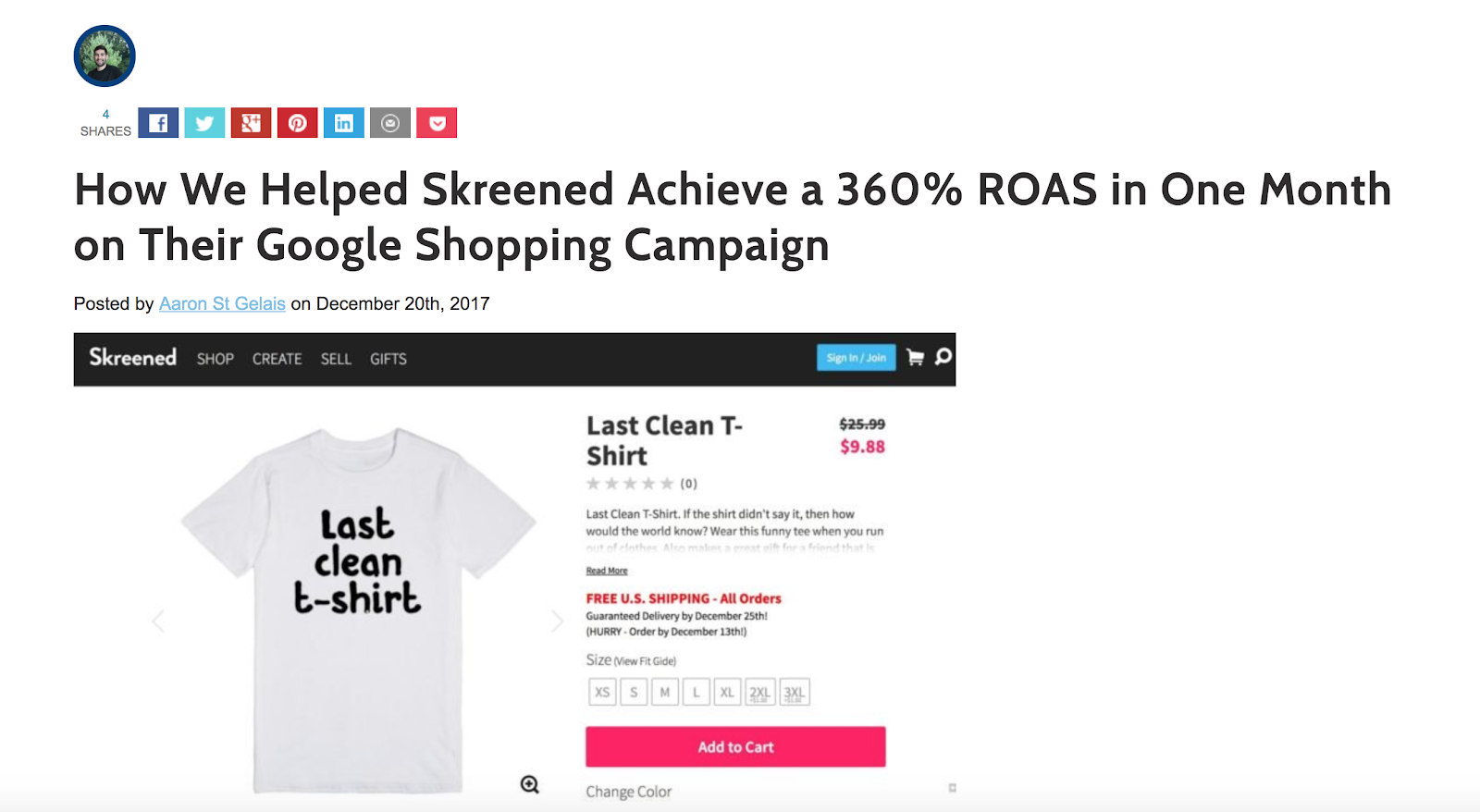
How We Achieved a 100/100 Google PageSpeed Score on Desktop and Mobile (And You Can Too)
From having our own agency, we knew that these types of case studies that share how they executed on one specific thing for a client showed the agencies expertise and that they can get results. These are some of the best pieces of content that you can produce for agencies because they show proof that you know what you’re doing.
We also helped them produce their best in class research report which they do annually, and helped them get a link to it from Shopify.
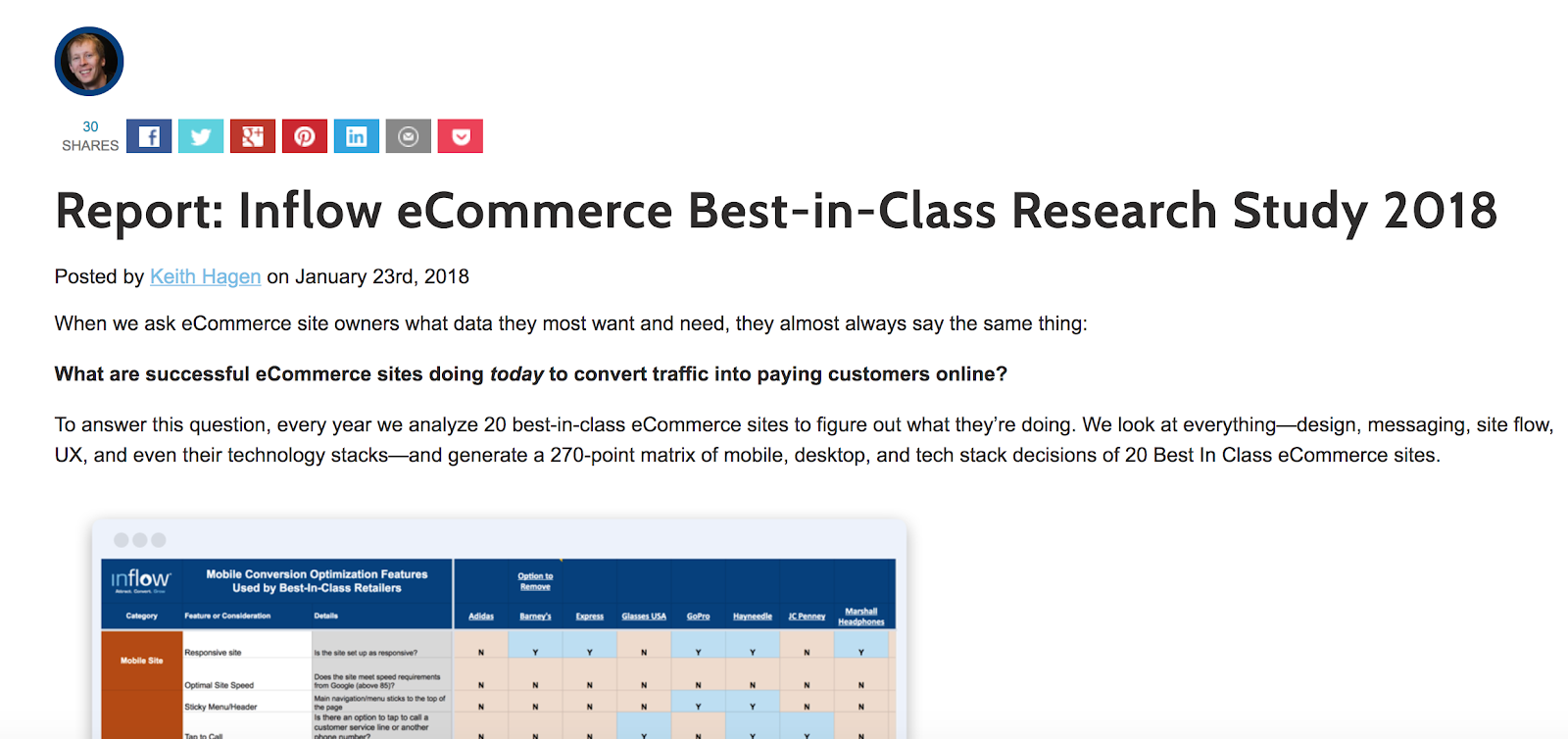
Here’s their article on the Shopify blog.
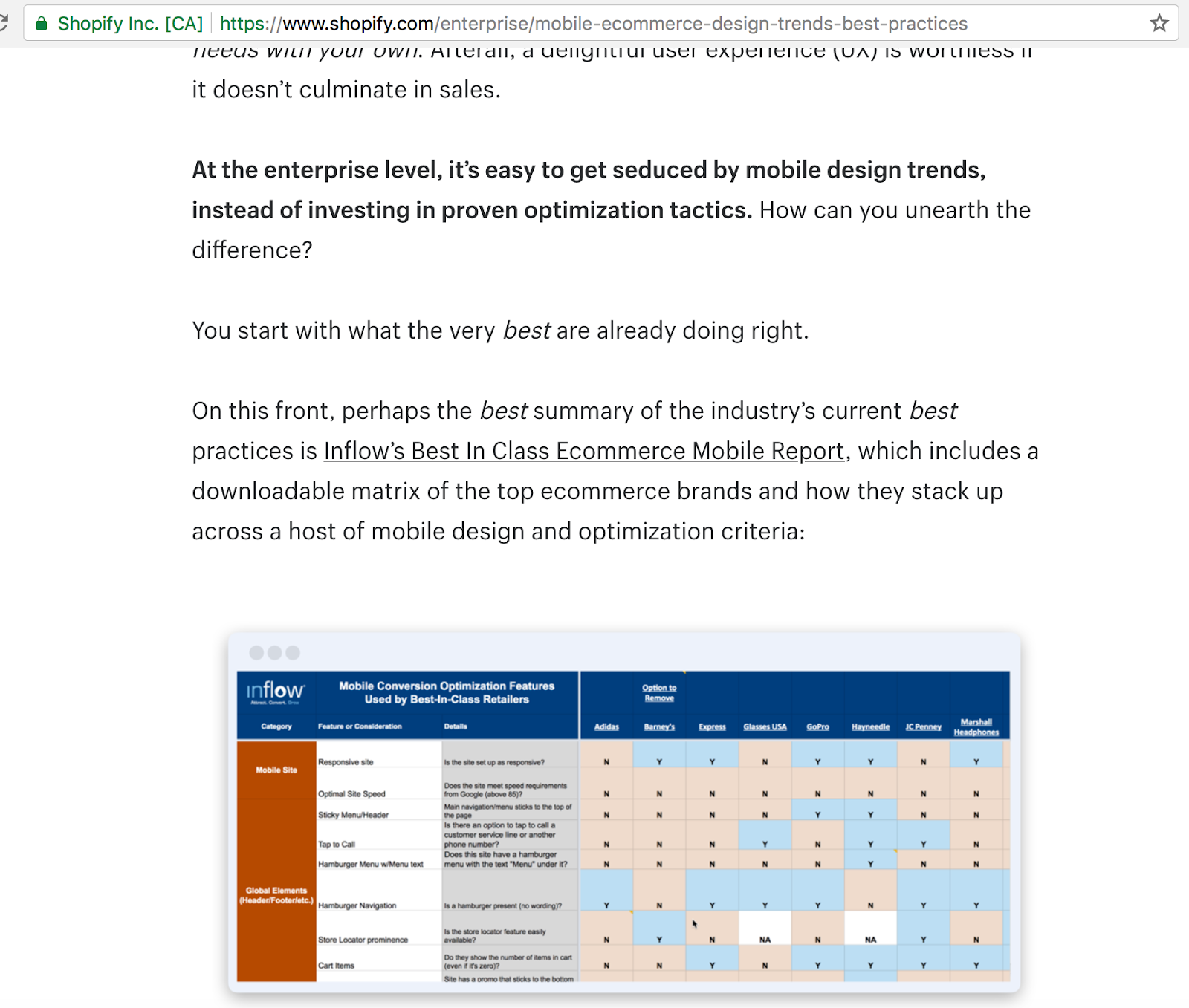
While their traffic isn’t as high as the other examples, we also just started with them and the traffic that we’re driving for them is super targeted, and in the first month of working with them, we’ve already seen sales leads (contact form fills) come from our efforts for almost every article that we’ve produced.
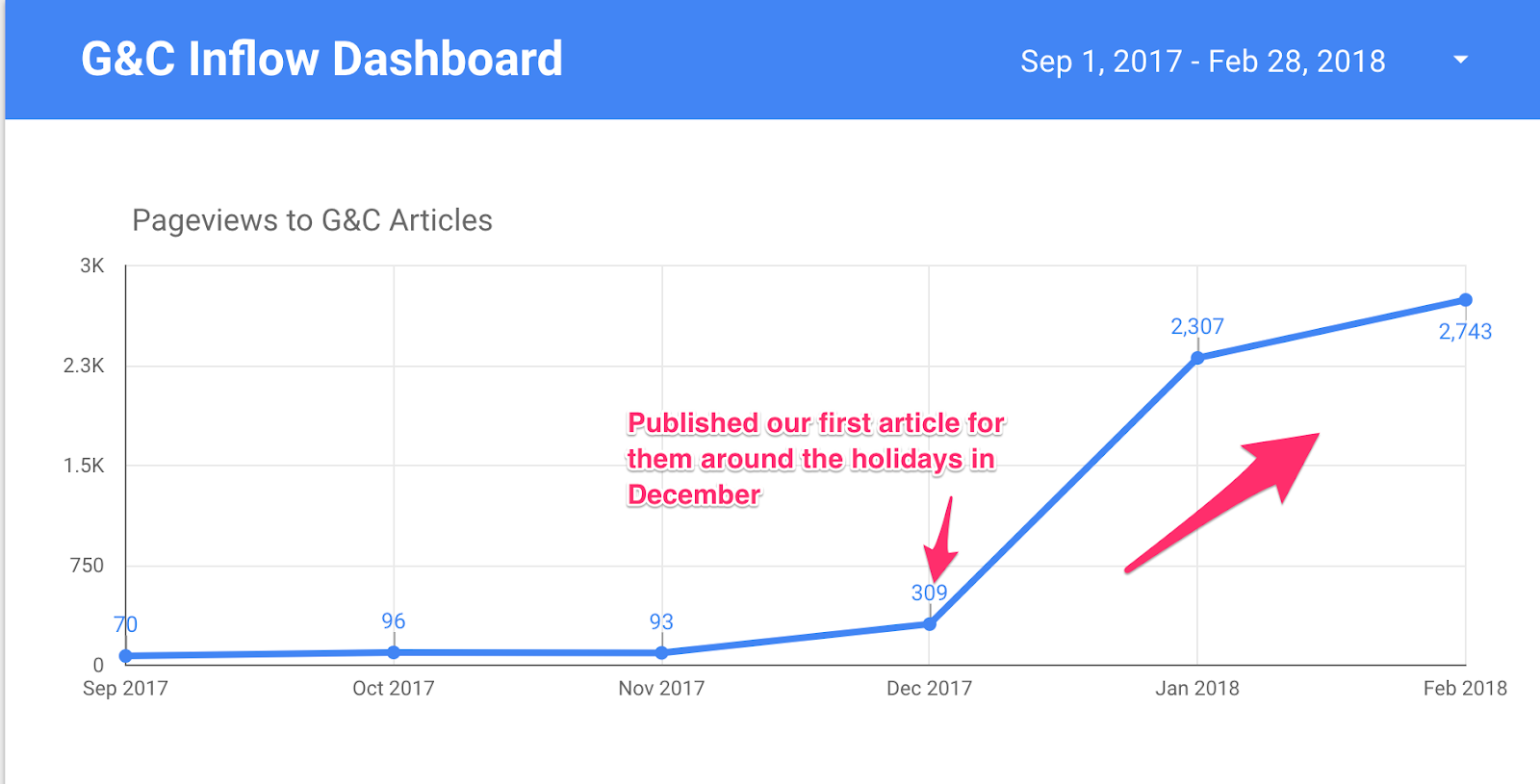
Note: There’s traffic on the previous months because we updated one of their articles that previously existed on an old URL.
How to Incorporate Funnel Thinking Into Your Content Strategy
On a single article level, you need to start thinking of each and every piece in terms of where in the funnel it is.
And on a macro-level you need to think of your entire content strategy in terms of how much of each type you’re going to produce.
So, if you are just starting out, and you need initial traffic, some links to build your domain authority, you may decide to put out a greater mix of top of the funnel pieces.
Or, for many B2B businesses (like for example, us and our agency), you don’t really need that much traffic, just a few leads/sales from the right customers are worth a lot, so you’ll then want to have most of your content be middle/bottom of the funnel, with just a few top of funnel articles mixed in that you think are on topics that still are uniquely valuable to your audience.
Don’t oversimplify, you’ll need a mix
Please don’t oversimplify this. We can’t think of a case where a company should produce just one type of content all day long. That would be boring. Too much bottom and you won’t get enough traffic to get good link building and domain authority for later. Too much top and you’ll have the common Goal 2 complaint of “we get lots of traffic, but no one converts”.
There’s obviously some mixing that’s required. The details of our goals, challenges, product, and target market will dictate that mix.
The best way to understand this is by example. So, here are 4 examples from 4 clients that we are actively working with at the time of publishing this article.
We customize the strategy for each client based on what they were trying to achieve, and while the traffic numbers may be wildly different for each of our clients, the content strategy is aligned with the goals they’re trying to achieve.
When coming up with your own strategy, first think of where you’re at and what your goals should be, then decide on your content strategy.
If you’d like to discuss getting similar results for your company, you can do it on our Work With Us page.
We also teach and coach our entire process in our course and content marketing community, including lots of detail and examples not found on this blog.
Join the Waitlist
Be the first one to know when our course is out.
Note: If you're not already on our email list, you'll also join it by entering your email below. It's free and marketers at companies such as Salesforce Desk, PayPal, and Cisco have joined.

